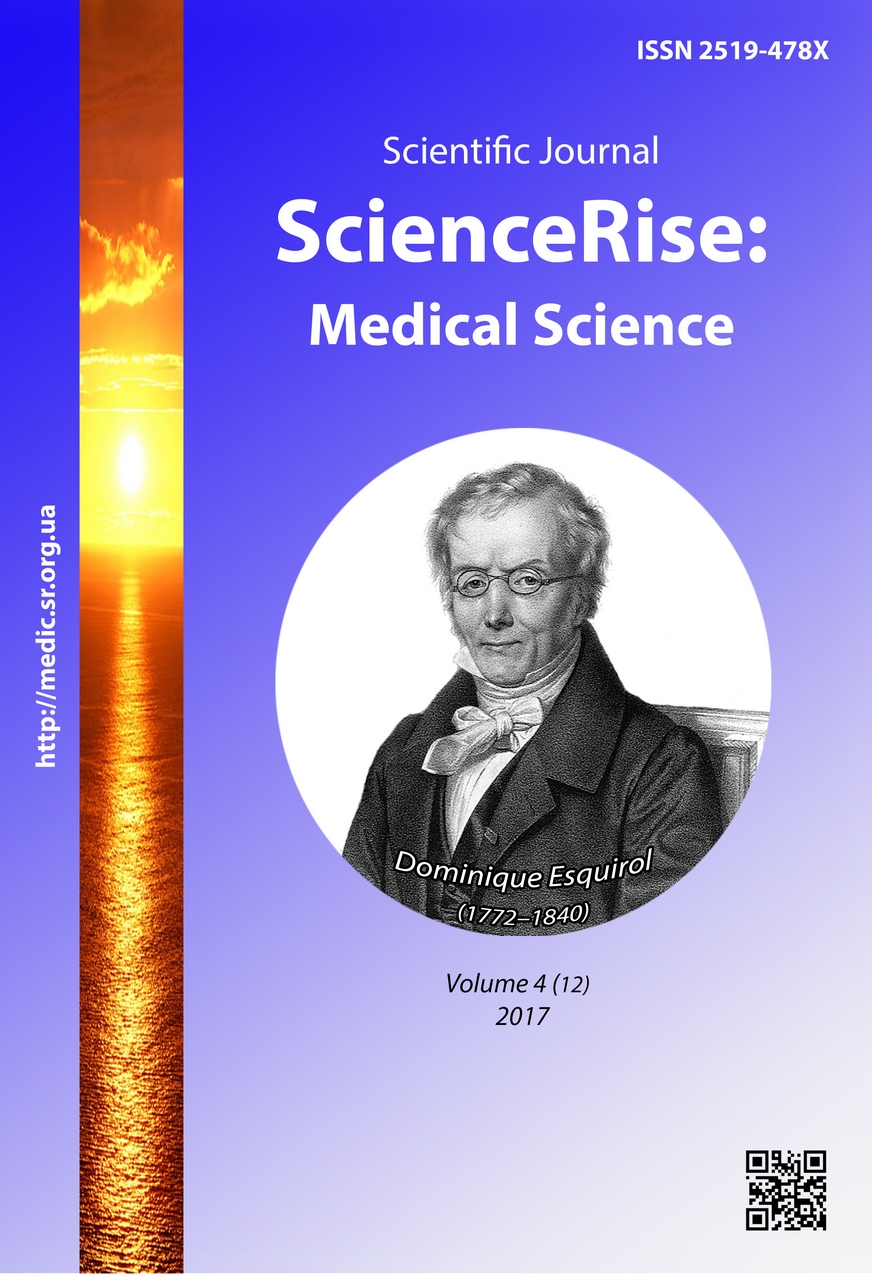The analysis of adhesive-dysfunctional endothely at resistant arterial hypertension
DOI:
https://doi.org/10.15587/2519-4798.2017.100135Keywords:
resistant hypertension, adhesive endothelial dysfunction, Bisoprolol, Telmisartan, AliskirenAbstract
Aim: To examine the antihypertensive activity of Telmisartan and Bisoprolol at resistant hypertension.To evaluate the features of resistant hypertension and endothelial vasomotor and adhesive dysfunction.
Methods: The level of adhesion molecules s-ICAM-1, L-selectin and matrix metalloproteinase-9 was determined by ELISA with regard to vasoactive function of the brachial artery, which is determined through the flow-dependent vascular dilatation sample. Determination of Nitrogen oxide was conducted on data metabolites of total Nitrogen (NOx) by determination of Nitrite ion after colorimetric reaction with Griess reagent using SF-46 spectrometer (Russia).
Results. The studies have shown that six-month treatment by Telmisartan and Bisoprolol in most patients (22 patients) was accompanied by target levels of blood pressure achievement, and was observed in 14 patients resistant to the treatment. The additional inclusion in complex treatment Aliskiren 150-300 mg per day was also accompanied by normalization of blood pressure.
Conclusion.
1. The function of endothelial adhesion and appearance of endothelial dysfunction occur prior to hypertension clinical and morphological signs.
2. Induced hypertension increase of sICAM-1 and L-selectin and matrix metalloproteinase-9 is a marker of hypertension severity and the treatment efficiency.
3. Telmisartan and Bisoprolol significantly reduce the adhesive endothelial dysfunction and contribute to the achievement of target blood pressure levelsReferences
- Ageyenkova, O. (2013). Application at an arterial hypertension of the fixed combination of preparations. Doctor, 4, 12–16.
- Aleksandrova, E. N., Novikov, A. A., Reshetnyak, Т. М. (2012). Soluble adhesion molecules in antiphospholipid syndrome associated with systemic lupus erythematosus and primary antiphospholipid syndrome. Therapeutist. Arch., 5, 23–27.
- Bondar, T. N. (2009). System L-arginine, nitric oxide and immunity. Theoretical and experimental medicine, 3, 4–8.
- Serkova, V. K., Poberezhna, H. V. (2010). Instrumental functions and biochemical indicators of vascular endothelium in patients with different clinical variants course of ischemic heart disease. Circulation and hemostasis, 3, 42–47.
- Xia, T., Liu, X., Du, C. J., Jin, X., Kong, X. Q., Li, G. (2015). A ssociation of Leu125Val polymorphisms in the PECAM-1 gene with the risk of coronary heart disease: a meta-analysis. Int. J. Clin. Exp. Med., 8 (2), 2219–2225.
- Kobalava, Zh. D., Kotovskaya, Yu. V., Bogomaz, A. V. (2015). The fixed combination of bisoprolol and amlodipine neutralizes the effect of β-adrenoblocker on the indices of the central pulse wave in patients with arterial hypertension. Cardiology, 12, 11–16.
- Proshchaev, K. I., Ilnitsky, A. N., Kvetnoy, I. M. et. al. (2015). Changes in the endothelium in cardiovascular diseases in the elderly. Part 2. Signaling molecules and the pathogenesis of atherosclerosis. Clinical medicine, 12, 4–7.
- Ageyenkova, O. (2013). Application at an arterial hypertension of the fixed combination of preparations. Doctor, 4, 12–16.
- Ward, A. M., Takahashi, O., Stevens, R., Heneghan, C. (2012). Home measurement of blood pressure and cardiovascular disease. Journal of Hypertension, 30 (3), 449–456. doi: 10.1097/hjh.0b013e32834e4aed
- Williams, I. L., Wheatcroft, S. B., Shah, A. M. (2002). Obesity, atherosclerosis and the vascular endothelium: mechanisms of reduced nitric oxide bioavailability in obese humans. International Journal of Obesity, 26 (6), 754–764. doi: 10.1038/sj.ijo.0801995
Downloads
Published
How to Cite
Issue
Section
License
Copyright (c) 2017 Ben Abid Mouna

This work is licensed under a Creative Commons Attribution 4.0 International License.
Our journal abides by the Creative Commons CC BY copyright rights and permissions for open access journals.
Authors, who are published in this journal, agree to the following conditions:
1. The authors reserve the right to authorship of the work and pass the first publication right of this work to the journal under the terms of a Creative Commons CC BY, which allows others to freely distribute the published research with the obligatory reference to the authors of the original work and the first publication of the work in this journal.
2. The authors have the right to conclude separate supplement agreements that relate to non-exclusive work distribution in the form in which it has been published by the journal (for example, to upload the work to the online storage of the journal or publish it as part of a monograph), provided that the reference to the first publication of the work in this journal is included.









